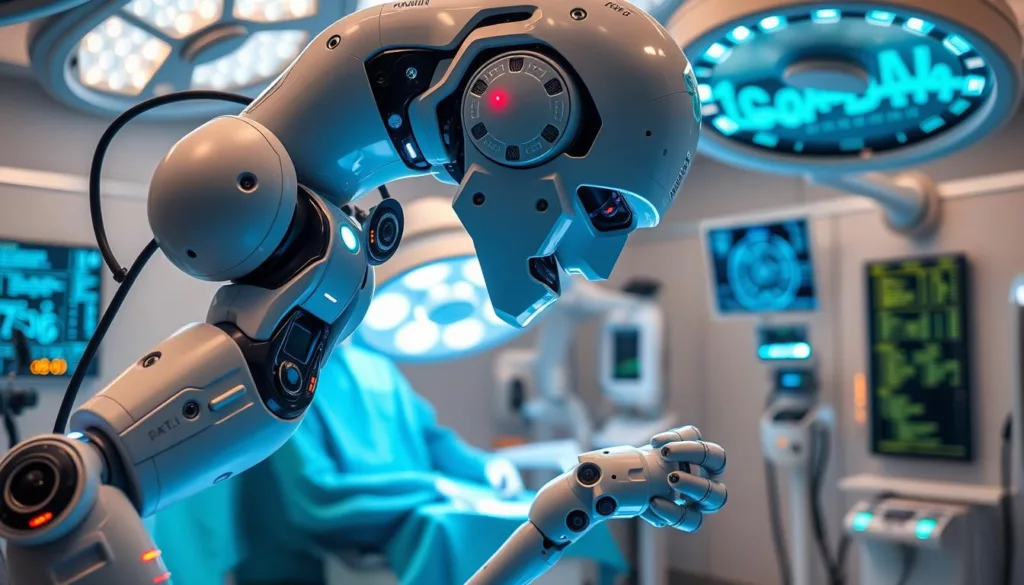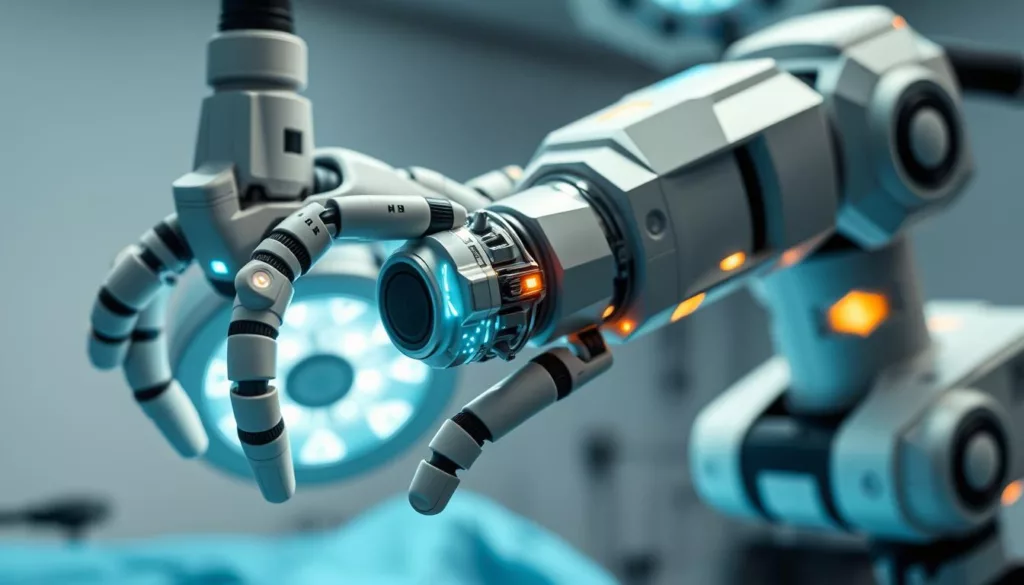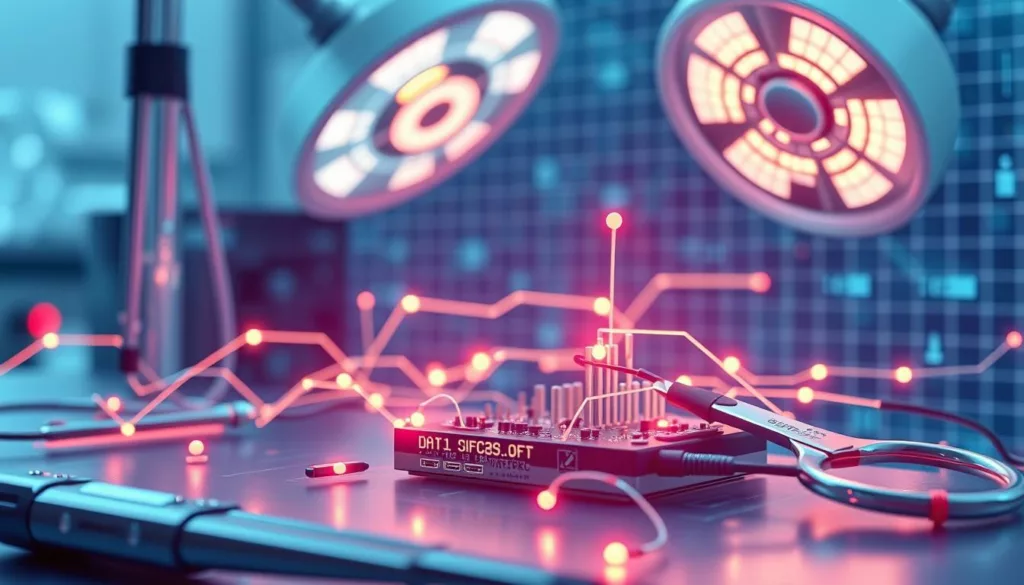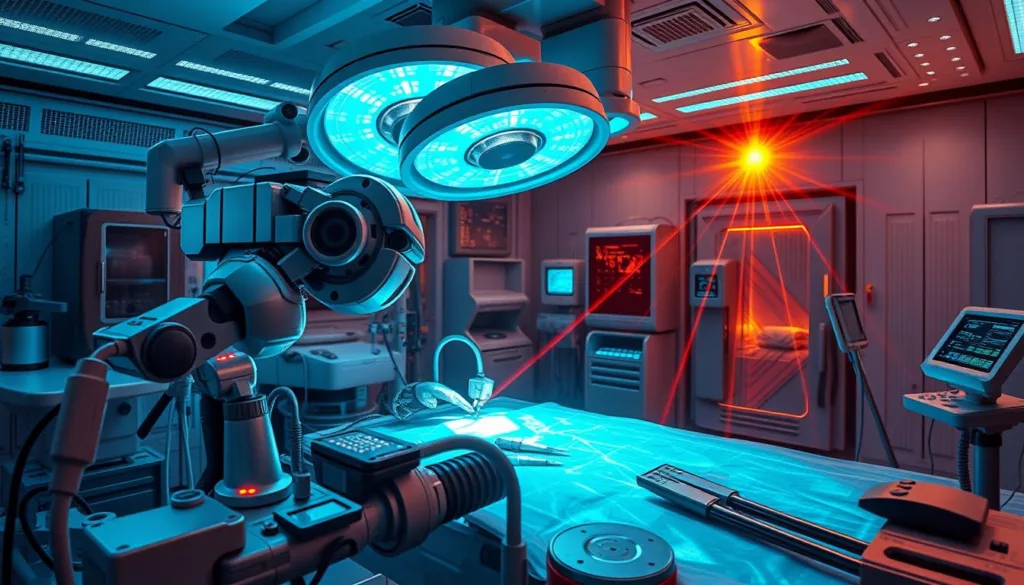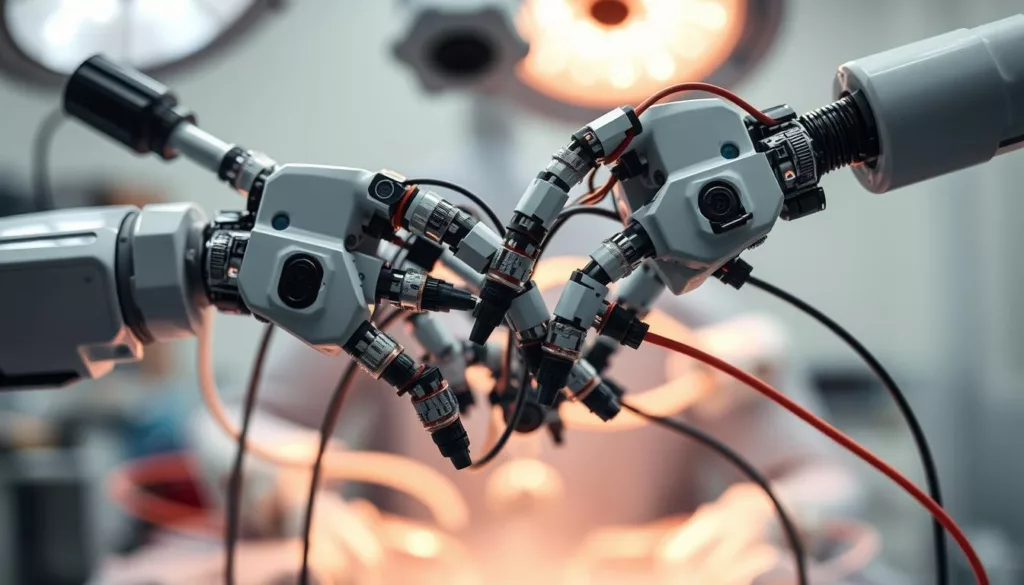Robotic surgery has changed how doctors perform surgery, making it less invasive. The heart of these systems is the sensors. They provide important data, making surgical robots more effective. In this section, we’ll discuss the top sensors used in robotic surgery. We’ll look at the new technologies that make surgeries better for patients. The focus will also be on how adding the right sensors to surgeries can make them safer and more successful.
Key Takeaways
- Robotic surgery revolutionizes minimally invasive procedures.
- Sensors are essential components of surgical robotics systems.
- Evaluating sensor quality is crucial for enhancing surgical precision.
- Innovations in sensor technology improve patient outcomes.
- Understanding sensor types is key to selecting the best options.
Introduction to Robotic Surgery Sensors
Robotic surgery has changed surgery in a big way. It lets surgeons operate with more precision and control. These advanced systems make surgeries less invasive, which helps patients recover better. Notable systems like the da Vinci Surgical System are widely used in many medical areas.
Overview of Robotic Surgery
Robotic surgery is a big leap forward in how operations are done. It merges a surgeon’s skills with the power of robotic arms. Surgeons use these systems to perform complex surgeries in areas like urology, gynecology, and heart surgery with high accuracy. This blend of human knowledge and robot precision lowers surgery risks.
Importance of Sensors in Robotic Systems
Sensors are key to robotic surgery systems. They gather important information about the surgery area. These sensors check on things like force, where something is, and what it looks like, allowing adjustments during the operation. Good sensors are crucial for robotic surgery to work well. They make sure the surgery is effective and safe, which is great for patient care.
Types of Sensors Used in Robotic Surgery
Sensors are key to improving surgical robotics. They give real-time data, helping surgeons operate precisely. Robotic surgery uses many sensor types, each with a special role. They make sure the surgery goes smoothly.
Force and Tactile Sensors
Force sensors check the pressure from robotic tools. They let surgeons feel the tissue as if they were touching it. This is crucial for careful surgery. Tactile sensors offer extra details about tissue texture. This info helps surgeons during the operation.
Pressure Sensors
Pressure sensors watch the pressure inside the belly during keyhole surgery. They keep the patient safe by alerting doctors if the pressure gets too high. These sensors are a must for a safe operation.
Imaging Sensors
Imaging sensors like cameras provide clear surgery views. They help doctors make better choices and improve patient outcomes. With these sensors, surgeons get an enhanced look that helps with precise work.
Key Features of Effective Surgical Sensors
Robotic surgery needs special features in surgical sensors. These are accuracy and precision, quick response, and the ability to work together with other devices. It’s how they help surgeons do their job safely and effectively.
Accuracy and Precision
Accuracy in sensors is critical for surgery. They help surgeons position their tools correctly, avoiding harm to nearby areas. It’s all about giving true data for safe and precise operations.
Response Time and Sensitivity
Surgeons need sensor response time to be quick. This lets them get updates right away during surgery. Sensitivity is also key for spotting the smallest changes. Together, they make surgeries safer and more successful.
Data Integration and Compatibility
Good surgical sensors must easily share data integration in medical sensors with other devices and programs. Being able to connect like this helps the surgery team work better as a unit. It leads to smoother operations and better care.
Leading Sensor Technologies in Robotic Surgery
In the world of robotic surgery, some sensor technologies are key. They make surgeries more accurate and keep patients safe. We’ll look at three main sensors: LIDAR in surgery, optical sensors, and ultrasonic sensors. Each one adds to what robots can do, making surgery better.
LIDAR Technology
LIDAR uses light to map out the surgery area in 3D. This gives surgeons a clear view of where they’re working. It makes robotic systems better at navigating. So, surgeries become more precise.
Optical Sensors
Optical sensors help surgeons see better during surgery. They use light to get high-quality images. This lets surgeons make better decisions. Clearer images mean better results in tough surgeries.
Ultrasonic Sensors
Ultrasonic sensors give important info about what’s inside the body. They use sound waves to help understand different tissues. This is useful in complex surgeries. Knowing the layers of tissue helps in getting good results.
Using these advanced sensors makes surgeries better and safer. It’s important to support such innovations. Companies like XJCSENSOR are key in advancing robotic surgery tools.
Impact of Sensor Quality on Patient Outcomes
Using high-quality sensors in robotic surgery greatly improves how patients recover. These sensors help by making surgery more precise, reducing problems, and shortening recovery time. Doctors use better sensors to improve surgery quality.
Enhanced Surgical Precision
Top-notch sensors make surgeries very accurate. They give surgeons detailed information. This lets them operate with more care. Surgical precision cuts down on mistakes, making surgery safer. Products like those from XJCSENSOR improve how robotic arms work. They help with exact movements during surgery.
Reduced Complications
Sensors play a big role in preventing problems after surgery. They help doctors keep an eye on things and make changes as needed. This keeps patients safe. High-quality sensors make sure issues are fixed quickly. This makes the entire surgery experience better.
Improved Recovery Times
Patients bounce back faster from robotic surgeries because they are less harsh on the body. Sensors help by being very careful with the body’s tissues. This speeds up healing. So, patients spend less time in the hospital and get back to their usual activities faster. This is a big step forward in how patients are taken care of.
| Factor | Effect on Patient Outcomes | Importance of Sensors |
|---|---|---|
| Surgical Precision | Reduces surgical errors | Essential for accurate data collection |
| Complications | Minimizes postoperative issues | Facilitates real-time adjustments |
| Recovery Times | Faster healing and discharge | Limits tissue trauma |
Challenges in Sensor Implementation
Adding sensors to robotic surgery has several hurdles. It’s vital for healthcare stakeholders to understand these challenges. They include technical problems, costs, and rules.
Technical Limitations
Sensors might not reach their full potential in range, sensitivity, or accuracy. This limits how well they perform in surgery. Such issues can affect patient results and the efficiency of robots.
Cost Considerations
Medical sensors are pricey. This affects decisions in healthcare settings. It’s hard to find a good mix of quality and cost. Many in the field struggle with this.
Regulatory Compliance
Medical devices, including sensors, must meet strict rules. This makes developing and using new tech hard. It can delay or halt sensor projects.
Innovations in Sensor Technology
The world of surgery is changing fast thanks to new sensor technology. These changes make robotic systems more precise and reliable. They also prepare the ground for new medical devices.
AI-Enhanced Sensors
Adding AI to medical sensors helps predict what might happen next in surgery. This improves decision-making. Surgeons get real-time data, letting them quickly adjust to patient needs. AI in sensors is making surgery safer and outcomes better.
Wearable Sensor Interfaces
New tech is improving wearable sensors for patients. These sensors monitor health data in real time. They help a lot with surgery planning and care after surgery. They keep track of vital signs and other health info. This gives doctors a big picture of patient health.
Miniaturization Trends
Sensors for surgery are getting smaller. This change is making a big difference. Smaller sensors take up less room and are easier to use. They fit better in robotic systems and are great for surgeries in tight spaces.
| Innovation Type | Description | Benefits |
|---|---|---|
| AI-Enhanced Sensors | Utilization of artificial intelligence to predict surgical outcomes | Improved decision-making and patient safety |
| Wearable Sensors | Real-time health monitoring for enhanced surgical planning | Increased postoperative care effectiveness |
| Miniaturized Sensors | Compact sensors designed for integration in surgery | Enhanced flexibility and reduced footprint in surgical tools |
FUTEK is at the forefront of these sensor innovations. Meanwhile, advances in torque sensors (see here) are boosting precision in surgery.
Future Trends in Robotic Surgery Sensors
The world of robotic surgery sensors is about to change a lot. New technologies and needs are driving these changes. We see a shift toward better performance and accuracy, highlighted by three major advancements.
Integration with Machine Learning
Machine learning is shaping the future of robotic surgery sensors. It lets sensors process tons of data for smoother operations. Sensors get smarter over time, making surgeries safer and more precise.
More Adaptive Sensors
There’s a move to make sensors that adjust in real-time during surgery. These sensors adapt to different situations, improving patient care. Their flexibility helps in achieving the best surgical results with fewer risks.
Rise of Remote Surgery Applications
Telemedicine is leading to more remote surgery sensors. These sensors work well even from afar, letting doctors handle complex surgeries remotely. This trend is making high-quality surgery more accessible and shows how ready we are for future tech.
Exploring future trends in surgical sensors highlights three key areas: machine learning, adaptive sensors, and remote surgery tech. These developments are making surgeries safer, more accurate, and accessible.
Case Studies: Successful Sensor Implementations
Looking at case studies in robotic surgery, we see big advancements. These come from adding sensors to the systems. Various sensors have made surgery better and safer for patients.
Da Vinci Surgical System
The da Vinci Surgical System leads the way with its sensor use. It combines imaging, force, and touch sensors. This mix helps surgeons do their work with amazing accuracy.
These sensors let doctors move with ease and get feedback as they work. This is key for surgeries to go well.
Medtronic’s Hugo™ Robotic Assisted Surgery
Medtronic’s Hugo™ system blends in new pressure and movement sensors. These are made for less invasive surgeries. Using these sensors, surgeons can do complex tasks easier, hurting patients less.
This leads to quicker healing and better experiences for patients. The Hugo system shows how important good sensors are in surgery.
Other Notable Systems
Other surgical robots also show how good sensor use can be. They bring in new tech like:
- Enhanced imaging capabilities
- Automated force feedback
- Real-time monitoring of intraoperative conditions
This variety in sensor use highlights their role in bettering robotic surgery. They push forward the improvements in how surgeries are done and how well patients do after.
Conclusion: Choosing the Right Sensors for Surgery
In the world of robotic surgery, picking the right sensors is key. These sensors need to match the specific needs of surgeries to work best. Understanding what each surgery requires helps pick the best sensor technologies. This ensures precision and reliability in surgeries.
Working together in medical tech is essential for using new sensors well. Doctors, engineers, and sensor makers need to team up. This teamwork brings better technologies to patient care. It makes sure sensors meet the real needs of surgeries. This way, we keep making surgeries better.
Looking ahead, we see sensor technology will continue to push surgery forward. New sensors will make surgeries smoother and improve results. This means better recovery for patients and more efficient healthcare. Advancements in sensors are crucial for the future of surgery.

